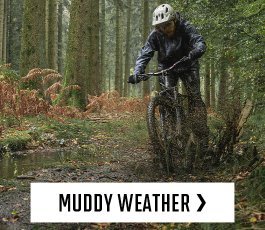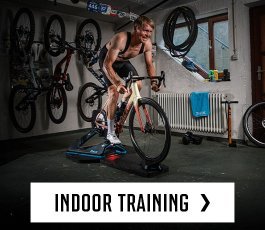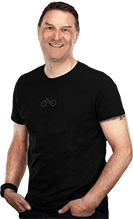Interview with TOGU Bike Balance Board designer Dr. Markus Braun
The Bike Balance Board is the ideal MTB exercise tool to improve your bike handling and get faster on the trail. Christoph met with its designer.
When MTB riders see the TOGU Balance Board for the first time, they are usually confused. How is this hybrid of a kick scooter and a skate board mounted on a deflated basketball supposed to train your bike handling skills and make you a faster, but also safer rider with only 10 minutes of practice per day?
Our product manager Christoph had the chance to meet with the board’s designer Dr. Markus Braun to learn how it works before and get a personal balance board class.

Christoph riding the TOGU Bike Balance Board.
Christoph: Hey Markus, this board of yours is a real full-body workout. I’m completely surprised. It’s super realistic in simulating the moves one makes on the bike when trail riding. How did you come up with the idea for the TOGU Balance Board? Would you mind explaining it to me a little better?
Markus: The idea behind the board really resulted from a personal experience. My wife and I had hit a road block in our evolution as mountain bikers. We simply felt stuck, we were not getting faster anymore and we even had a lot of crashes and felt unsafe. Our riding was lacking the necessary fun and we even thought about quitting. I started wondering how we could improve our bike handling to become faster and safer riders without having to invest too much time. Ultimately, the goal was to have more fun on the bike.
When you think about it, the position on the Balance Board is very much like the way you stand on your bike. All the movements have to be coordinated from your body core through your hips. It’s all about keeping the balance while you are moving.
The Balance Board exercises all follow the same pattern. You briefly force the board out of balance in order to move it back into equilibrium. That’s the main principle. It’s very similar to your bike’s behaviour on the trail. Hence, it’s the ideal body motor control exercises for mountain bikers.
Christoph: You emphasize that the board trains your motor control skills. That’s surprising! Usually, for MTB the focus lies on strength and endurance. Why not simply go ride to train these skills?
Markus: To train motor control skills means to practice movements and movement patters. Translated into cycling, that’s steering and manoeuvring with the bike. Of course, you can totally do that on the bike, but you always risk crashing and injuries. The goal is to practice new movements that your brain and body have not performed yet. This always involves the risk of failure. This should be avoided at all cost. The TOGU Balance Board gives you the chance to train theses movements effectively off the bike without risking a crash. After, you try it on your MTB.

Here, Christoph is simulating a descent.
Christoph: That makes sense. I have never looked at it that way. It’s really more like supplementing my normal training on the bike rather than replacing it.
Markus: Correct! It supplements your technical training of bike handling skills on the bike. Even better, it provides you with the necessary pre-requisites for it. The training on the Balance Board provides you with the elementary skills for training on the bicycle.
To train and practice means to go to your limits. In this case, scientifically, we speak of the individual motoric threshold. That’s where the optimum effect of the training is produced. If you were to train this way on the bike, it would mean to consciously risk a crash and injury. That is completely unacceptable. And that is the reason why multiple World Champion Nino Schurter was one of the first regular Balance Board users. With it, he can train on a very high level, even during the season without risking injury.
Christoph: : Awesome, that makes sense! At the beginning you said that I will be able to ride faster with only a very short period of training on the board. How does that work?
Markus: The number of repetitions of each movement and movement sequence that you perform on the Balance Board during even a short amount of exercise time is a lot higher than on your MTB. That translates into quicker and more efficient learning. And that in return means, that you ride faster and safer more quickly.
To explain why training on the Balance Board works, I want to give you a quick background from neuroscience. Movements and movement patterns are basically memorized in your brain. Your brain creates motoric and sensory maps and each movement is saved on these maps. Once this happens, your body can execute the movement without having to consciously think about it. That’s very much like walking, talking, breathing etc. Your movements are automated and that’s how it should be on the bike as well. Automation brings speed and safety.

Dr. Braun and Christoph sat down to chat about the Balance Board.

The Balance Board effciently trains your motor control, making you faster and safer.
Christoph: How much time do I have to invest in training with the Balance Board?
Markus: 10 minutes is a good exercise time. The biggest factor is frequency. Do it for 10 minutes a day, that’s ideal. After 10 to 20 minutes your brain is worn out. Nino Schurter has integrated the balance board into his full-body workout plan. It’s one ingredient of his recipe for success.
Christoph: That is nothing. Anybody has 10 minutes to spare. But is this for pros only, or can a beginner train with the balance board as well?
Markus: Absolutely! Especially riders that are just starting out can benefit tremendously as they can improve their safety on the bike quickly and avoid crashes.
In addition, the balance board is a scalable training tool. That means that the difficulty level of the exercises can be adjusted to the skill level of the user.

You can even simulate jumps.
Christoph: How do you adjust the difficulty and the intensity?
Markus: The scalability of the Balance Board can be regulated with the ball. Basically, a smaller and softer ball makes for a slower and easier to handle board. Vice versa, a bigger and harder ball makes it faster and more difficult. You can easily regulate the ball’s size by adjusting the air pressure with the help of the pump that comes with it. You start out with a soft small ball and then you keep increasing its size and pressure over time.
The individual exercises are detailed in the training manuals. There is a vast array of exercises that simulate specific bike manoeuvres like dropping and turning etc.
Christoph: That’s genius, so you never stop learning with the Balance Board. I have another question though. How come the TOGU Bike Balance Board has such a steep price tag? 599 Euro is not exactly a bargain.
Markus: There are really two reasons. On the one hand, the design and development process was extremely time and cost intensive and then there are high production costs. The board is 100% manufactured and assembled by master carpenters and engineers in Germany. The platform is made using state-of-the-art CNC-5 machines. The steerer tube is made from premium stainless steel and receives its final touches by hand. Keep in mind that TOGU is the world’s leading manufacturer for air-ball based training tools. The “Made in Germany” quality has its price.
Christoph: The premium craftsmanship and high quality is clearly visible. But what exactly is the R&D process?
Markus: The Balance Board is a clean product, while very complex in its functionality. Only with our board were people able to balance on top of a ball for the first time. That had never been done before, it’s a real innovation and to get it just right, we had to manufacture a lot of costly prototypes. Mating the physics of balance training tools with the physics of mountain biking is a complex science. As a result, we had to make sure that our intellectual property is protected and patented several design features.
Christoph: That is really impressive. I see the value. I think all your time and effort invested has been well worth it. Thank you so much for taking the time to share all this information with me. I will get back on to the bike ….I mean, the board to ride a few more trails.

-

































